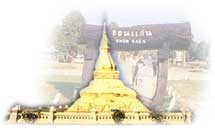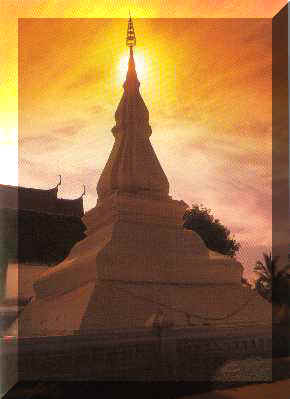Khonkaen
![]()

As the "Northeastern Capital", Khonkaen boasts many attractions including interesting cultural legacies.

![]() Phra
That Kham Kaen is an ancient monument highly-revered by the people in the region. Its
location is in Wat Chetiyaphum in Nam Phong district 36 km. from the provincial capital.
The monument is shaped like an angular lotus bud and is 19 m. high from its square brick
and mortar. The monument 's crchitectural stlye is similar to that of the old Phra That
Phanom which is a prototype of many monuments in the Norhteast.
Phra
That Kham Kaen is an ancient monument highly-revered by the people in the region. Its
location is in Wat Chetiyaphum in Nam Phong district 36 km. from the provincial capital.
The monument is shaped like an angular lotus bud and is 19 m. high from its square brick
and mortar. The monument 's crchitectural stlye is similar to that of the old Phra That
Phanom which is a prototype of many monuments in the Norhteast.
![]() Khon Kaen National Museum is located within the provincial civil
service center and houses archaeological objects abd works of art of different
periods from the Upper Northeast, especially the numerous beautiful stone boundary markers
of the Dvaravati period.
Khon Kaen National Museum is located within the provincial civil
service center and houses archaeological objects abd works of art of different
periods from the Upper Northeast, especially the numerous beautiful stone boundary markers
of the Dvaravati period.
![]() Ku
Puay Noi
Ku
Puay Noi
Khonkaen's largest ancienr Khmer sanctuary, Ku Puay Noi, is located near the That Ku Thong monks' habitation in Puay Noi subdistrict, 76 km. from the provincial town.
The sanctuary camprises three brick stupas on laterite bases and a laterite library in the sotheast corner, all surrounded by a low rectangular wall.There are two entrances, one in the fromt (east) and the other at the back. The entrances are large structures with exquisitely-carved sandstone doorway columns. The carved designs indicate that the sanctuary was built between the 11th and 12th centuries and was restored in the following century.
![]() Ku
Kaew is a small Khmer sanctuary
located in the compound of the Ku Kaew Samakkhi monks' quarters at Ban Sa in Tambon Don
Chang, Muang district 25 km. from the provincial town.
Ku
Kaew is a small Khmer sanctuary
located in the compound of the Ku Kaew Samakkhi monks' quarters at Ban Sa in Tambon Don
Chang, Muang district 25 km. from the provincial town.
There are a stupa and a library built of laterite and sandstone, surrounded by a laterite wall. A pond wite laterite steps at its edge is at the northeast corner outside the wall.
During the restoration, a stone inscription and many images of the worship were discovered. According to the inscription, the sanctuary was built by King Jayavarman VII's order, for religious rites and for curing the people. So Ku Kaew was one of the healing-houses mentioned in other stone inscriptions of the period. The sanctuary belongs to 13th century Mahayana Buddhist style.
![]()